-

人教版新目标初中英语七年级下册Where did you go on vacation教案
句型: Where did you go on vacation? I went to summer camp.Did she go to Central Park?Yes,she did.No, she didn’t语法:一般过去时特殊疑问句、一般疑问句及肯、否定回答。课时安排4课时第一课时:Section A:la,1b,lc,2a,2b,2c 第二课时:Section A:3a,3b,4第三课时:Section B:1,2a,2b,2c第四课时:Section B:3a,3b,3c,4 and Self Check第一课时教学目标掌握描写假期生活的形容词。假期里自己所做事情的简单表达。谈论假期做的事情及当时情况。谈论假期时旅游的天气,旅游者以及食物等。教学过程一、导入播放一首英文歌曲:Let’s travel 说明:通过让学生听节奏欢快迪斯尼英语歌曲Let’s travel.引入本节课谈论的话题vacation and travel. 让歌曲使学生的思维活跃,增强课堂气氛,激发学生提高学习英语的兴趣。T:How is the trip ?Ss : It’s pretty good/ happy/exciting /relaxing/busy/dangerous/ fantastic说明:这个问题是为了操练形容词。建议让多个Ss作答。鼓励他们用不同的形容词。上述个别形容词本应在第二课时中出现,但可以在warming-up中第一次非正式出现。这些形容词也可在老师的评价语中适时出现,以加深学生对词汇的印象。

人教版新目标初中英语九年级下册Rainy days make me sad教案
1. 教材分析本单元以how do things affect you?为话题, 从颜色、天气、音乐、广告、产品等方面谈论了外界事物如何影响人的心情。要求学生掌握表达某物或某事给人带来的感觉、看法或影响等。共设计了四个部分的内容:Section A 该部分有4个模块:第一模块围绕Which restaurant would you like to go to?这一话题展开思维(1a)、听力(1b)、口语(1c)训练;第二模块围绕How does music affect you? 进行听力(2a-2b)、口语训练(2c);第三模块继续围绕how do colors in the restaurant affect you这一话题展开训练,训练形式为阅读和问题体验(3a)和小组活动(3b);第四模块仍就How do things affect you这一话题以调查的形式展开讨论。Section B该部分有4个模块:第一模块围绕产品广告对人们的影响这一话题以“配对”(1a)与“列举”(1b)两种形式展开训练;第二模块继续围绕How do things affect you? 进行听力(2a-2b)、口语对话训练(2c);第三模块围绕“Advertising”这一话题展开阅读(3a-3b)和写作(3c)训练;第四模块围绕How posters affect you这一话题以口语训练形式展开小组活动。

人教版新目标初中英语九年级下册I’ll help clean up the city parks教案
Talk about offering help (P60)I’ll help clean up the city parks.A: I’d like to work ...B: You could help ...Talk about ways to tell people about the Clean-Up Day (P61)We need to ...We can’t ...I’ll ...Talk about the work the volunteers do (P62)These three students all volunteer their time to help other people.Somebody loves to ... / helps ... / plans to ... / wants to ...A: What do you like doing?B: I like ... A: What kind of volunteer work do you think I could do?B: You could ...1. 重点词汇advertisement, fix, repair, pleasure, blind, deaf, shut, carry, specially, fetch2. 认读词汇hunger, homeless, cheer, clean-up, sign, establish, major, commitment, elementary, veterinarian, coach, similar, call-in, strategy, disabled, organization, unable, support, appreciate, donation, part of speech, pronoun, adverb, preposition, conjunction, donate, Jimmy, Sally3. 词组clean up, cheer up, give out, put off, set up, think up, take after, fix up, give away, put up, hand out, work out, at once

人教版新目标初中英语七年级下册Where is your pen pal from教案
2.1Match the country with the language.Step II Reading3a? let the students read the letter fast and answer the questions.? Let the students ask more questions about the letter as possible as the can.Step III Writing3b.Step IV. Pairwork2cStep V Listening2a, 2bStep V. HomeworkExercises book(1) P3Exercises book (2) P3Period FourStep I . Dictate the words and sentences in Unit1.Step II. Self-checkStep III. Check the answers for Exercises book in the unit.Step IV. Home workRevise and preparation for unit 2.教学反思:通过本单元的学习,学生基本可以谈论人们的国籍,居住城市及其所说的语言,通过书信方式去介绍自己并寻找笔友。但在涉及到国外的一些城市时,学生对这方面的知识相对欠缺,能介绍的城市并不多,也反应出学生课前预习不充分,这跟学生学习条件也有关,大多数学生无法通过网络获取所需信息。因此,在以后的教学中要多指导学生通过计算机网络获取信息,拓宽知识面。

人教版新目标初中英语七年级下册What do you think of game shows教案
五、教学Section B-2c1. Pair work: What do you think of the belt/sunglasses/…? What does your father/mother/… think of your scarf/belt…?2. Group work(1). Teacher shows some different kinds of school uniforms (制服)and asks : “ What do you think of your school uniforms? If you have a chance to choose your school uniforms, what kind would you like to choose?”(2). Discuss in groups.(3).Get some Ss to report in class.说明:这一步旨在让学生运用已有的语言知识谈论对事物的看法和意见,并简单阐明理由,培养学生的主动思维能力和运用英语的能力。六、教学拓展调查电视节目的收视率任务:调查你周围的人对现在各种电视节目的反响。活动过程:1.教师布置任务,让学生调查周围的人(包括他的亲戚朋友和邻居)喜欢收看哪方面的电视节目。2.学生进行调查活动,运用本单元所学的句型What do you think of….? (Why?)What's your favorite game shows?What do you think of talk show?I doesn’t mind it.I like it.I love it.I can’t stand it.3.记录下排在前10位的TV Program,填写调查表,比较其收视率。

人教版新目标初中英语八年级下册Have you ever been to an amusement park教案
(1)Have you ever been to …? Yes, I have. / Yes, I have ever been to …No, I haven’t. / No, I have never been to …(2)When did you go there? I went there last year. (3)I have never been to a water park. Neither have I. I have ever been to an amusement park. So have I. (4)How long have you been studying English? I’ve been studying English since nine o’clock. I’ve been studying English since I came back home. I’ve been studying English for five hours. (5)What’s that? It’s an amusement park in Japan. I’ve never been to an amusement park like it before. It’s fun to learn another language. Let’s go tonight. Isn’t this great?space museum, amusement park, water park, South America, Peru, Holland, European culture, tour guide, flight attendant, musical instrument, more than, be from, get to, take lessons, neither, discover, graduate, change

人教版新目标初中英语八年级下册Why don’t you get her a scarf教案
教师带领学生复习有关描述宠物的词汇,采用教师提问学生回答的方进行。如:T:What animals do you think would be good pets?What animals do you think would be bad pets?What do you think are good animals for a six-year-old child?然后学生进行 pairwork 练习。Task two: 师生互动,学习探究 1、播放3a部分的录音,引导学生一边听录音,一边跟读。2、通过听录音学生回答以下问题:Why do you think pot-bellied pigs are popular?What are the advantages and disadvantages of keeping such a pet?教师对学生的回答进行及时点评。3.学习范文,学习重点短语,为下步的模仿写作提供语言素材。T :1. )Have you ever kept a pig as a pet?Do you like pigs? St.:No.…Why don’t you like to keep a pig? St: No.They’re too dirty and lazy(Do you know in some foreign countries like Hollyland, Australia,pigs are the most popular pet.there’s a kind of pig.(图)it has an interesting name? it ‘s called a pot-bellied pig.) Now,let’s learn an article about this kind of interesting pet.2.)play the tapeSt.:Listen and repeat3.)show some Qs on computer(本子St.: read silently,then answerthe Qs(本子)4.)Ask ss. Close book and retell this passage.(what is a pot-bellied pig? Is it a good or bad pet? ) St.: retell it to each other“A pot –bellied pig is a popular pet now…”5.read the article together.St.:.practice reading

人教版新目标初中英语九年级下册By the time I got outside, the bus had already left教案
Ⅰ. Teaching Aims and Demands1. Knowledge Objects(1) Key Vocabularyoversleep(2) Target LanguageWhat happened?I overslept. And by the time I got up, my brother had already gotten in the shower.2. Ability Objects(1) Teach the students to use the new words.(2) Train the students to narrate past events with the Past Perfect Tense.(3) Train the students' listening and speaking skills with the target language.3. Moral ObjectIt’s a good habit to go to bed early in the evening and get up early in the morning. So you’ll never be in a hurry in the morning.Ⅱ. Teaching Key Points1. Key Vocabularyoversleep2. Target LanguageNarrate past events with the Past Perfect TenseⅢ. Teaching Difficult Points1. Train the students to narrate past events with the Past Perfect Tense.2. Train the students to understand the target language in spoken conversation.Ⅳ. Teaching Methods1. Thinking of examples from the students' real lives.2. Making sentences by looking at the pictures.Ⅴ. Teaching AidA tape recorderⅥ. Teaching ProceduresStep I Revision1. Revise the language points in Unit 8.Ask some questions like this: What volunteer work would you like to do?Help the students to answer, I’d like to…/I love to…/I hope to2. Practice the dialogue in Activity 3c on page 62 again. Get students to role play the similar dialogues with the following.

人教版新目标初中英语九年级下册Could you please tell me where the restrooms are教案
Step Ⅰ RevisionCheck homework. Ask a few students to read the article in 3a.Then ask a few students to read their guides.Step Ⅱ Part 1Look at the words in the box. Ask a student to read them. Make sure the students understand the meaning of the words. You are to fill in the blanks with the words. In some cases, students may need to use another form of the word, for example adjusting for tense or subject/ verb agreement.Ask students to fill in the blanks on their own.Check the answers. Step ⅢPart 2Go through the instructions with the class.Look at the example with the students.Ask students what the answer would be.Ask a student to read the question and answer it.Excuse me, could you tell me where the bank is, please?The bank is across the street from the shopping malt.Get students to complete the work in pairs.Check the answers. Ask a few students to read their questions.Step Ⅳ Just for Fun!Ask all the students to read the conversation. Ask: What is funny about this cartoon? Help students to explain. A Martian is a person from the planet Mars.There is no such thing as Martian food on Earth, and the clerk looks silly because he is trying to think of where there is a Martian restaurant.Invite some pairs of students to present this conversation to the rest of the class.Step Ⅴ Summary and HomeworkIn this class, we’ve done much writing practice using the key vocabulary words and the target language presented in this unit. After class, please finish the questions in 2 in your exercise books. Then finish the exercises on pages 47~48 of the workbook as well.The Seventh Period Ⅰ Teaching Aims and Demands1. Knowledge Objects(1) Key Vocabularyimage, adventure, jealousy, hero, crime, journey, brave, no longer, show interest in, take it easy, become interested in, plain looks(2)Text:Grown-ups like cartoons, too.2. Ability Objects(1) Fast-reading to get a general idea of the text.(2) Careful-reading to get the detailed information in the text.
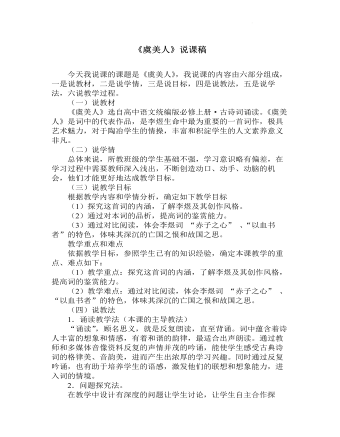
古诗词诵读《虞美人(春花秋月何时了)》说课稿 2021-2022学年统编版高中语文必修上册
(一)说教材 《虞美人》选自高中语文统编版必修上册·古诗词诵读。《虞美人》是词中的代表作品,是李煜生命中最为重要的一首词作,极具艺术魅力,对于陶冶学生的情操,丰富和积淀学生的人文素养意义非凡。(二)说学情总体来说,所教班级的学生基础不强,学习意识略有偏差,在学习过程中需要教师深入浅出,不断创造动口、动手、动脑的机会,他们才能更好地达成教学目标。(三)说教学目标根据教学内容和学情分析,确定如下教学目标(1)探究这首词的内涵,了解李煜及其创作风格。(2)通过对本词的品析,提高词的鉴赏能力。(3)通过对比阅读,体会李煜词 “赤子之心” 、“以血书者”的特色,体味其深沉的亡国之恨和故国之思。
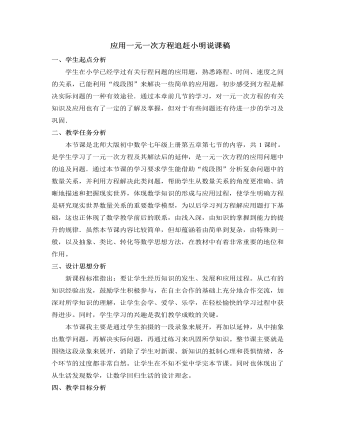
北师大初中数学七年级上册应用一元一次方程追赶小明说课稿
目的:进一步理解追击问题的实质,与课程引入中的灰太狼追喜羊羊故事呼应,问题得到解决。环节三、运用巩固活动内容:育红学校七年级学生步行郊外旅行,1班的学生组成前队,步行速度为4千米/小时,3班的学生组成后队,步行速度为6千米/小时,1班出发一个小时后,3班才出发。请根据以上的事实提出问题并尝试回答。问题1:3班追上1班用了多长时间 ?问题2:3班追上1班时,他们离学校多远?问题3:………………目的:给学生提供进一步巩固建立方程模型的基本过程和方法的熟悉机会,让学生活学活用,真正让学生学会借线段图分析行程问题的方法,得出其中的等量关系,从而正确地建立方程求解问题,同时还需注意检验方程解的合理性.实际活动效果:由于题目较简单,所以学生分析解答时很有信心,且正确率也比较高,同时也进一步体会到了借助“线段图”分析行程问题的优越性.
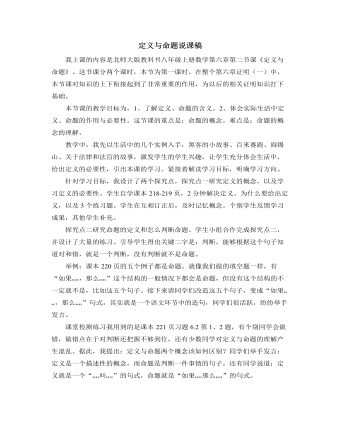
北师大版初中八年级数学上册定义与命题说课稿
接下来请同学们改造这五个句子,变成“如果??,那么??”句式,其实就是一个语文环节中的造句,同学们很活跃,纷纷举手发言。课堂检测练习我用到的是课本221页习题6.2第1、2题,有个别同学会做错,做错点在于对判断还把握不够到位,还有少数同学对定义与命题的理解产生混乱。据此,我提出:定义与命题两个概念该如何区别?同学们举手发言:定义是一个描述性的概念,而命题是判断一件事情的句子。还有同学说道:定义就是一个“??叫??”的句式,命题就是“如果??那么??”的句式。在教学中,学生对定义与命题的把握还是比较清楚的。大部分学生可以口头完成导学案设计的题目。能够迅速的把一个命题转化成“如果?那么?”的形式.利用疑问句和祈使句的特点,判定不是命题的语句.迅速的掌握情况还是比较可以的。
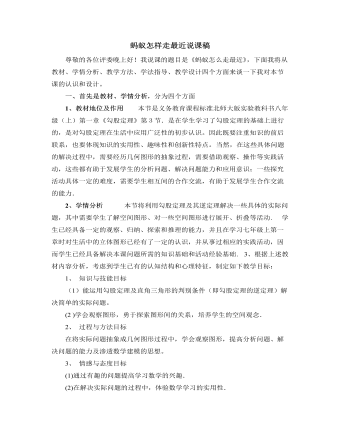
北师大版初中八年级数学上册蚂蚁怎样走最近说课稿
学生以小组为单位,合作探究蚂蚁爬行的最短路线,充分讨论后,汇总各小组的方案,在全班范围内讨论每种方案的路线计算方法,通过具体计算,总结出最短路线。让学生发现:沿圆柱体母线剪开后展开得到矩形,研究“蚂蚁怎么走最近”就是研究两点连线最短问题,引导学生体会利用数学解决实际问题的方法:建立数学模型,构图,计算.意图:通过学生的合作探究,找到解决“蚂蚁怎么走最近”的方法,将曲面最短距离问题转化为平面最短距离问题并利用勾股定理求解.在活动中体验数学建摸,培养学生与人合作交流的能力,增强学生探究能力,操作能力,分析能力,发展空间观念.3.突破重点、突破难点的策略在教学过程中教师应通过情景创设,激发兴趣,鼓励引导学生经历探索过程,得出结论,从而发展学生的数学应用能力,提高学生解决实际问题的能力.
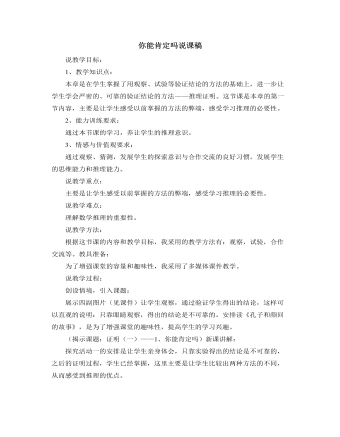
北师大版初中八年级数学上册你能肯定吗说课稿
探究活动二的安排,是要让学生明确只靠实验得出的结论,可能会以点带面,从而进一步说明学习推理的必要性。并小结出:如果要判断一个结论不正确只要举一个反例就可以了。探究活动三的安排是说明只靠实验得出的结论也不可靠,必须经过有根有据的推理才行。活动交流:(1)在数学学习中,你用到过推理吗?(2)在日常生活中,你用到过推理吗?这是一座桥梁,把课堂引向推理的方法。例题的安排,可以让学生学会简单的推理方法,同时增强学生的学习兴趣。课堂练习:①游戏:苹果在哪里?②判断:是谁打破玻璃?把练习变成游戏的形式,也是为了增加课堂的趣味性,提高学生的学习兴趣。课堂小结:进一步明确学习推理的必要性。课后作业:①课本习题6.1:2,3。②预习下一节:定义与命题
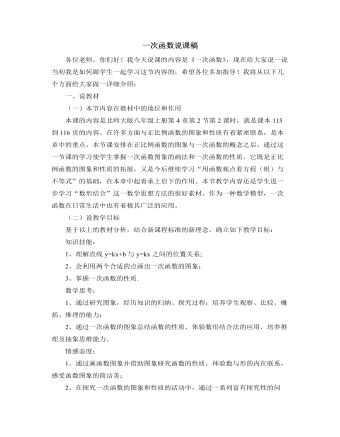
北师大版初中八年级数学上册一次函数说课稿
引导学生回忆所学知识。通过这节课的学习你得到什么启示和收获?谈谈你的感受.目的:总结回顾学习内容,有助于学生养成整理知识的习惯;有助于学生在刚刚理解了新知识的基础上,及时把知识系统化、条理化。(四)作业布置加强“教、学”反思,进一步提高“教与学”效果。四、说板书设计采用了如下板书,要点突出,简明清晰。一次函数正比例函数图像的画法:确定两点为(0,0)和(1,K)一次函数选择的两点为:(0,k)和(-b\k,0)五、说课后小结实践证明,在教学中,充分利用教学方法的优势,为学生创造一个好的学习氛围,来引导学生发现问题、分析问题从而解决问题。多媒体课件支撑着整个教学过程,令学生在一个生动有趣的课堂上,能愉快地接受知识
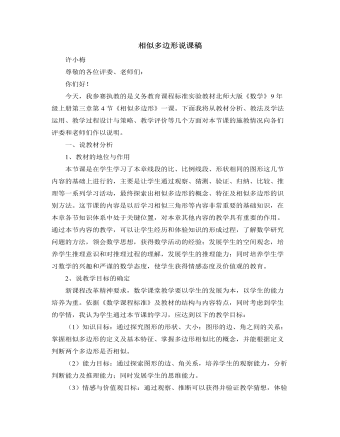
北师大版初中数学九年级上册相似多边形说课稿
五、说课件设计及板书随着教育现代化的发展,多媒体课件在课堂中辅助教师授课,帮助学生练习,已成为非常重要的教学辅助工具之一。在本节课的授课过程中,本人也使用了多媒体教学课件。课件在设计上遵循实用性原则、辅助性原则、创新性原则,紧紧围绕教学目标,服务于课堂教学,设计科学合理,制作精美细致;课件的有效使用很好地优化了课堂,极大地扩充了容量,有力地突出了重点,轻松地化解了难点;使学生学习兴趣浓郁,使教学效率大大提高;特别是在演示多边形对应角相等的设计,使这一教学环节变得更直观、更高效、更方便,让学生轻松地进行探究,很好地保护了学生的学习热情,方便了教师的策略实现。在授课过程中,我又不是完全依赖于多媒体课件,而成了课件反映员;我充分发挥教师的主导作用,合理地利用黑板板书有关内容,灵活动配合多媒体课件为学生呈现有关知识点,以弥补课件的不足。
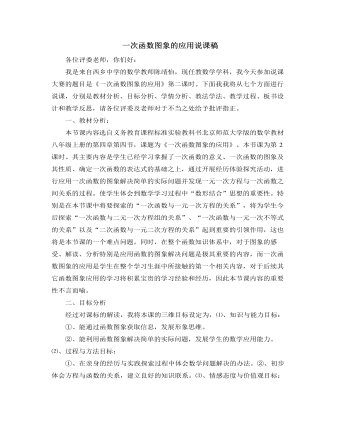
北师大版初中八年级数学上册一次函数图象的应用说课稿
本环节运用了一个阶梯式的问答方法,帮助突破本节课的难点。同时,从具体的实际问题入手,由特殊问题到一般规律的揭示,不仅解决了难点问题,而且从另外一个角度讲也渗透给了学生的数形结合思想,还有利于学生主动探索意识的培养。4、自主评价本环节主要是应用本节课所学的知识以及所积累形成的学习经验和体验解决问题的过程,即课堂巩固训练。在练习题的选择上,由简单到复杂。先是结合图象获取信息进行简单的填空和选择,此题属于A组题型,检验学生的掌握情况;然后进行了一道B组题,关于“一次函数与一元一次方程的关系”知识点的灵活运用,进一步通过练习体会它们的关系。5、自主发展:最后一道则是特殊的区别于之前所学习的分段函数练习,发散学生思维问题的训练。让学生体会分段函数的特点,并掌握求分段函数解析式的方法。
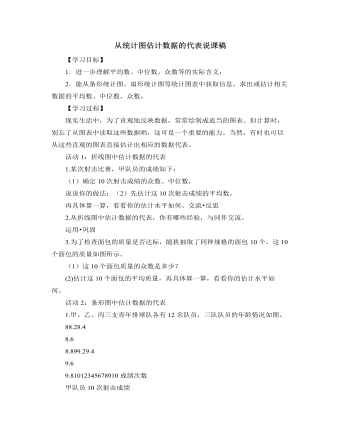
北师大版初中八年级数学上册从统计图估计数据的代表说课稿
1.小明调查了班级里20位同学本学期计划购买课外书的花费情况,并将结果绘制成了下面的统计图.(1)在这20位同学中,本学期计划购买课外书的花费的众数是多少?(2)计算这20位同学计划购买课外书的平均花费是多少?你是怎么计算的?反思?交流*(3)在上面的问题,如果不知道调查的总人数,你还能求平均数吗?2.某题(满分为5分)的得分情况如右图,计算此题得分的众数、中位数和平均数。活动4:自主反馈1.下图反映了初三(1)班、(2)班的体育成绩。(1)不用计算,根据条形统计图,你能判断哪个班学生的体育成绩好一些吗?(2)你能从图中观察出各班学生体育成绩等级的“众数”吗?(3)如果依次将不及格、及格、中、良好、优秀记为55、65、75、85、95分,分别估算一下,两个班学生体育成绩的平均值大致是多少?算一算,看看你估计的结果怎么样?*(4)初三(1)班学生体育成绩的平均数、中位数和众数有什么关系?你能说说其中的理由吗?
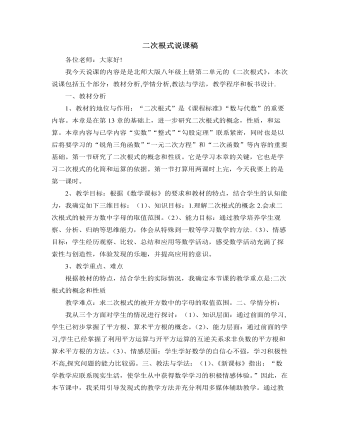
北师大版初中八年级数学上册二次根式说课稿
有意义,字母x的取值必须满足什么条件?设计意图:通过例题的讲解,使学生加深对所学知识的理解,避免一些常见错误。而变式练习设计,延续的例题的风格,一步一步,步步深入,本节课的教学难点就在学生的操作活动中迎刃而解了。对提高学生对所学知识的迁移能力和应用意识,激发好奇心和求知欲起到良好效果。(五)、巩固运用,提高认识1、通过基础训练让学生体验学习的成就感。2、应用拓展:增加难处,再次让学生联系以前的知识,增强学生的数学应用意识。(六)、总结评价,质疑问难这节课我们学习了什么?设计意图:学生共同总结,互相取长补短,学生在畅所欲言中对二次根式的认知得到进一步的巩固升华。五、板书设计.采用纲领式的板书,使学生有“话”可说,有“理”可循,在简单板书设计中使学生体会到数学的简洁美。
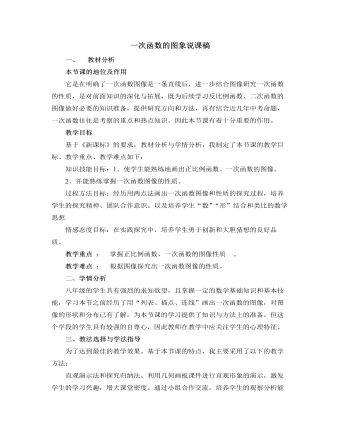
北师大版初中八年级数学上册一次函数的图象说课稿
[互动2]师:请大家从上面的解题经历中,总结一下如果已知函数的图象,怎样求函数的表达式?小组讨论之后再发表意见。生:第一步根据图象,确定这个函数是正比例函数或是一次函数;第二步设函数表达式;第三步:根据表达式列等式,若是正比例函数,只要找图象上一个点的坐标就可以了;若是一次函数,则需要找到图象上两个点的坐标,然后把点的坐标分别代入所设的解析式中,组成关于R、b的一个或两个方程。第四步:求出R、b的值第五步:把R、b的值代回到表达式中就可以了。师:分析得太好了。那么,大家说一说,确定正比例函数的表达式需要几个条件?确定一次函数的表达式呢?要说明理由。生:确定正比例函数需要一个条件,而确定一次函数需要两个条件。原因是正比例函数的表达式:y=Rx(R≠0)中,只有一个系数R,而一次函数的表达式y=Rx+b(R≠0)中,有两个系数(待定)R和b。